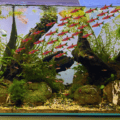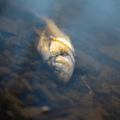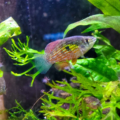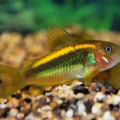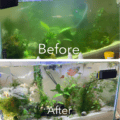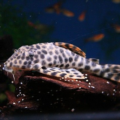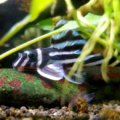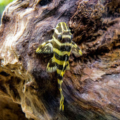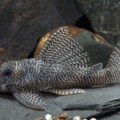All the reasons why the vibrant Clown Pleco striped catfish is perfect for small aquariums and beginner hobbyists. In this article we will provide feeding, health care, breeding tips and everything in-between about the Clown Pleco (Panaqolus sp. L206).

Introduction
Are you interested in keeping a suckermouth catfish but don’t want the basic-looking dark black/gray variant? I have a striped aquatic marvel you’ll love for its physical features and traits—Panaqolus sp. L206, a.k.a. Spotted Tail Clown Pleco.
This beginner-friendly clown pleco is a star in its own right because of its bold stripes and love for driftwood. You can express yourself with interesting aquarium decorations without worrying about how it’ll affect your Panaqolus sp. L206’s Introduction in the tank.
Also, this species is well suited to compact aquariums and requires minimal maintenance, making it perfect for beginner aquarists. So, here’s a comprehensive guide on caring for your new pets.
See Also: 14 Small Pleco Species (Under 4.3″ in Adult Size) for more small plecos!
The Striking Elegance of Clown Pleco Patterns

Spotted Tail Clown Plecos have a distinct zebra-like stripe pattern that creates a dynamic visual contrast with aquarium decor. They’re also compact, growing only up to 3.1 inches (7.9 cm) long in adulthood.
Let’s take a closer look at this patterned freshwater Pleco and its color variations.
Color Patterns
Generally, this Zebra-striped aquarium fish has a dark base color like other variants of its species. But its top coating of vibrant yellow to-orange sometimes gray stripes separates the Clown Pleco from others.
Also, each of Clown Pleco has varying stripe intensity depending on genetics and maintenance.
Unique Traits
| Fin Type | Features |
| Dorsal | Plain with a fan-like shape |
| Caudal (Tail) | Striped and Sharp |
| Pectoral | Striped with soft edges |
| Ventral | Striped with soft edges |
Spotted Tail Clown Plecos are nocturnal fish, so they’re mostly active at night and in dim spaces, and they love eating algae.
Before I highlight how to use maintenance to enhance your pet’s physical appearance, let’s discuss the other traits that characterize this small ornamental Pleco.
Tailoring the Perfect Habitat for Clown Plecos
You can create an optimal Panaqolus aquarium for your Spotted Tail Clown Pleco by providing clean water, appropriate decor, and calm surroundings. Here’s how to achieve the ideal habitat with your freshwater fish tank designs.
Tank Size and Layout
Ensure your tank holds at least 20 gallons of clean water with ample driftwood and rock formations for shelter and breeding. Build a layout they can easily navigate without knocking over pieces of decor or harming themselves.
Water Parameters
| pH range | 6.5 – 7.5 |
| Temperature | 73 – 82℉ |
| Hardness | Soft to Moderately Hard | 5 – 15dGH |
Decor Tips

Using the right decor is the final step in creating Clown Plecos habitats. You must balance visual appeal with practicality.
Pick soft substrates like fine sand and smooth gravel for the floor. Use plant-based shelters with rocks and caves to replicate their natural habitat. Some examples include Mopani driftwood, hollow logs, Java Fern, and Amazon Sword.
Crafting a Balanced Diet for Clown Plecos

Panaqolus sp. L206 is a wood-eating aquarium pleco, which is why driftwood is essential to their environment. They depend on the wood fibers and algae growth for digestion but also need protein sources for muscle development.
Diet Suggestions
Don’t rely on your Clown Pleco to clean algae in the aquarium as its only source of food, be ready to prepare an algae-focused pleco feeding meal plan. Here’s how you can guarantee a balanced diet for Panaqolus:
| Staples (Main Meals) | Supplements (Occasional Meals) |
| Algae, Driftwood | Algae Wafers, Vegetable Slices (Zucchini, Peeled Peas, Sweet Potatoes), Protein pellets (Shrimp, Bloodworms) |
For more on feeding your aquatic pets check out The Ultimate Guide to Fish Food: Pros and Cons & Best Choices!
Feeding Schedule
Feeding routines for Clown Plecos must accommodate their nocturnal nature. So, feed them 1 – 2 times daily, but mostly in the evening to night time. You can leave enough food for them to graze during the day but not too much that it’ll lead to waste or overfeeding.
See Also: Bristlenose Plecos (Ancistrus cirrhosus): The Ultimate Algae Cleaners For Your Aquarium
Building a Peaceful Community for Clown Plecos

Because of their peaceful temperament, Clown Plecos are compatible with a wide range of non-aggressive species. Follow this small, peaceful fish guide for the best result.
Consider physical traits when searching for Clown Pleco tank companions. Compatible species for harmonious freshwater setups are Small barbs, Danios, and Peaceful shrimps while you should avoid territorial or predatory fish.
Extending the Lifespan of Clown Plecos: Long-Term Care Strategies
Following this freshwater fish lifespan enhancement section of our guide guarantees your pets will thrive for up to 110 years, which is the longest they can ever live (joking).
It is simple actually, give your Spotted Tail Clown Pleco proper nutrition, consistent water conditions, and a stress-free environment.
Lifespan Factors
From what they need to live long, you can guess the lifespan factors that contribute to your pet’s health.
- Clean water
- Proper diet
- Minimal tank disturbance
Advanced care for Plecos focuses on keeping pristine water in optimal condition, feeding a balanced plant-based diet, and ensuring a stress-free tank.
Care Tips for Longevity
More Clown Plecos longevity tips include regular observation to spot illnesses and proactive tank maintenance to prevent them quickly.
Breeding Clown Plecos: Insights and Best Practices

Clown Pleco breeding methods are similar to other egg-laying fish species but it can be challenging because of their breeding habits. They need cooler and softer water with rich diets and secluded spawning areas during this period.
Breeding Setup
You can use the same parameters for your breeding tank as your main tank but keep the levels on the lower ends of the scale. Allow natural breeding behaviors for Panaqolus spawning success.
Male Clown Plecos choose a cave and clean it for the females who lay 20 – 50 eggs at once.
They’ll then fertilize externally and fan the eggs for oxygen while protecting them.
Fry Care Tips
Within 5 – 7 days, the fertilized eggs will hatch and feed on their yolk sacs while the male Clown Plecos stand guard until they become free-swimming. You can then supplement their diets with powdered fry food, blanched vegetables, and crushed algae wafers.
Don’t forget to add driftwood for natural grazing behaviors and continue regular tank maintenance practices like changing 20 – 30% of the water weekly.
See how easy fry rearing in aquariums can be when you do all the necessary things.
Avoiding Common Health Pitfalls in Spotted Tail Clown Plecos
Unfortunately, even the best healthy Clown Pleco care may not save your pets from typical health challenges. However, they can reduce the chances because common illnesses come from poor nutrition, water-quality issues, and poor maintenance.
Preventative Measures
They include:
- Performing regular water changes every week to keep the tank clean
- Serving sufficient dietary fiber to meet your Clown Pleco’s nutritional needs
- Avoiding overcrowded tanks by maintaining a 20-gallon/pair ratio
- Preventing aquarium fish stress by keeping only compatible species.
Signs of Stress or Illness
Understanding these common indicators of illnesses helps in identifying Pleco health issues.
- Decreased activity,
- Color fading,
- Lack of appetite
The illnesses may be bacterial, fungal, nutritional, or environmental. So, it is best to visit a vet for accurate diagnosis and treatments. For first aid, though, you should quarantine the affected fish and change the water.
Conclusion
I’ll close this Panaqolus aquarium guide by highlighting this species’ key qualities to answer the biggest question – “Why Choose Clown Plecos?” they’re
- Small and adaptable to compact tanks
- They are physically attractive because of their striped and spotted patterns
- Natural algae cleaners with their grazing abilities
- Low maintenance and perfect for beginner aquarists
- Vibrant appearance in freshwater tanks.
You can always come back to this guide for more beginner fish care essentials if you choose to keep this vibrant species in your tank.

